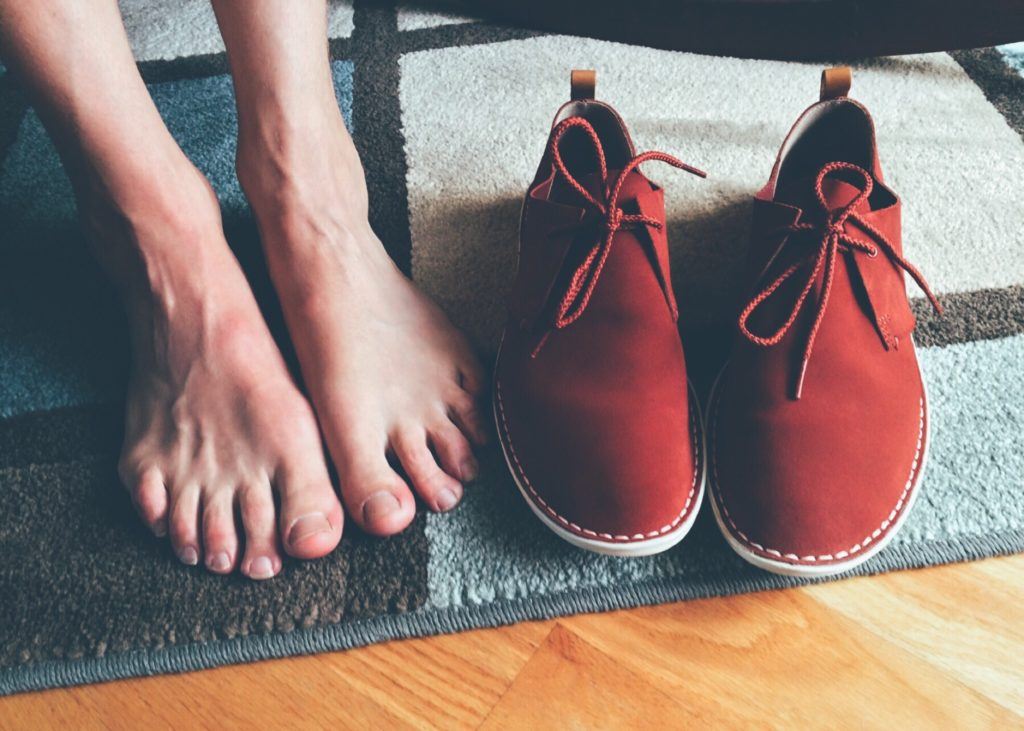In our modern times, we are very much aware of the state of our health. Everywhere you look, there are warnings about how our lack of movement causes issues both mentally and physically.
Indeed, the rising popularity of running, walking, and jogging is a testament to this new-found consciousness.

With all this talk of walking and running and jogging, we sometimes ignore the fact that there are injuries you can gain from exercise. The most common injury is, in fact, tarsal tunnel syndrome.
Contents
Tarsal Tunnel Syndrome
Have you ever walked too much in one day, or wore shoes that were terrible for your feet, only to come home with your feet aching?
Other than the usual spots, like your soles and the tips of your toes, chances are the muscles inside your ankle hurt too. If it’s a pain that persists, this may be a symptom of tarsal tunnel syndrome.
The Tarsal Tunnel
So, what exactly is the tarsal tunnel itself? The tarsal tunnel is the narrow space between the flexor retinaculum (the ligament below your ankle) and the ankle bones (specifically the medial malleolus).
This narrow space houses other structures, such as arteries, veins, tendons, and nerves. Most importantly, it also houses a nerve called the posterior tibial nerve. This nerve is what provides information taken from your feet to your brain.
Tarsal tunnel refers to the compression of this nerve. This compression is most often caused by the presence of swelling inside the tunnel, which places pressure on the tibial nerve.
This is why tarsal tunnel syndrome is also referred to as posterior tibial neuralgia, which literally means pain in the posterior tibial nerve. This manifests as inner ankle pain, causing a tingling and burning sensation that’s quite unpleasant in the ankle.
In a way, tarsal tunnel syndrome functions a lot like carpal tunnel in feet. With carpal tunnel syndrome, it is the median nerve in the wrist that is irritated, causing extreme discomfort.

In tarsal tunnel syndrome, it is the tibial nerve that is agitated, causing ankle nerve pain.
Causes of Tarsal Tunnel Syndrome
There are many different causes of tarsal tunnel. Commonly, its causes can be grouped into three categories: injury, diseases, and anatomy.
Injury
Because we do a lot of things on foot, our feet are a prime location for injury. This is exacerbated by people who play contact sports, especially those which take a huge toll on the feet (such as running or exercises like walking and jogging.)
Common reasons for tarsal tunnel syndrome are injuries that cause trauma to the ankle, such as a sprain.
Even something as small as a sprain can inflame the inside of your tarsal tunnel, which then puts pressure on the tibial nerve. If left untreated, this sprain may result in complications.
Diabetes
Along with other complications, diabetes can also cause tarsal tunnel syndrome.
One of the symptoms of diabetes is swelling in the extremities, such as the hands and feet. This swelling also puts pressure on the tibial nerve.
Arthritis
Arthritis is a wide term that refers to any illness that is present in the joints. This illness often leads to swelling, pain, and stiffness in the joints.
Just like diabetes, arthritis can also cause swelling in the tarsal tunnel, putting pressure on the tibial nerve.
Abnormal Structures
Another cause of tarsal tunnel is abnormal structures present inside the foot. These structures may be growths such as a varicose vein, cysts, or an arthritic bone spur.

Since these structures should not be there, they push against bones, veins, and muscles, irritating the inside of the foot.
Specifically, one of the diseases that can lead to abnormal structures is neurofibromatosis, which is a disease that causes the formation of neurofibromas.
Anatomy
And finally, sometimes the cause is the structure of the foot itself. There are some people who are born with feet that are more prone to swelling, due to their natural structure.
People with flat feet, for example, will have a higher chance of developing tarsal tunnel syndrome. The outward tilt of their heel can place pressure on the nerve, which can lead to pain and irritation.
When to See Your Doctor
When you experience pain in your ankle, it would be best to let it heal on its own. You may also treat your foot with light exercises, as well as cold compresses.
However, if the swelling does not go down on its own in a day, it’s best to see your doctor. Untreated tarsal tunnel syndrome will only worsen, causing more damage in the foot.
Severe cases will require surgery to treat. On top of that, untreated tarsal tunnel syndrome can leave you with permanent nerve damage, which will affect everyday activities even after treatment has been administered.
Tarsal Tunnel Symptoms
If you feel a tingling on the inside of your ankle, how do you know that if it’s tarsal tunnel or just a pain that will go away on its own?
To determine whether you have tarsal tunnel, the following symptoms are considered:
- Shooting pain in the foot.
- Numbness.
- Tingling or burning sensation in the ankle.
- Pain that spreads toward the rest of the leg.
Diagnosis
When diagnosing tarsal tunnel, your doctor will put you through a comprehensive clinical exam. This exam will include asking for symptoms that you may experience in relation to the pain in your foot.

They may ask for sensations of pain, such as inside ankle pain, as well as other sensations in the area. Your doctor may then do a physical examination of your foot, noting any signs of swelling and inflammation.
Your doctor may also check your medical history, noting any diseases that may cause tarsal tunnel, as well as any previous injuries that could result in tarsal tunnel syndrome.
One of the tests that your doctor may conduct is a Tinel’s test. When you were young, you may have undergone a test in which a physician tapped your knee to check for reflexes.
A Tinel test is very similar to this procedure, only now your doctor isn’t checking for reflexes, but rather to detect pain and irritation in the nerves.
A Tinel test involves tapping on a certain part of the body and asking the patient if they feel a tingling sensation in certain areas. If there is tingling felt, this means that the sign is positive and that there are irritated nerves in the area.
For example, a positive Tinel test for carpal tunnel is a tingling sensation in the thumb, index finger, middle finger, and half of the fourth digit.
The Tinel test conducted to determine tarsal tunnel syndrome is slightly different. Your doctor will begin with flexing the foot and extending all the toes. They will then gently tap just over the tarsal tunnel.
A positive Tinel sign is the presence of tingling in the local nerve area.
Other than a Tinel test, there are other procedures that your doctor may perform on you, including an MRI or an X-ray. These tests will ensure that your doctor’s diagnosis is correct, while at the same time gauging the severity of your condition.
Here’s a video explaining more details on tarsal tunnel syndrome.
Treatment Options for Tarsal Tunnel Syndrome
When it comes to treatment options for tarsal tunnel, your doctor will first explore options that don’t involve surgery.
These non-surgical treatment options will be recommended to you by a physician depending on the severity of your tarsal tunnel syndrome, sometimes combining different treatments to help heal your foot.
The goal of non-surgical treatment is to help hasten the natural healing capacity of your body through different means.
The following are a list of nonsurgical treatments that your doctor may recommend in order to help your tarsal tunnel syndrome heal.
Rest
As with every illness, the first thing that your doctor would recommend to you is rest. Removing any pressure on the affected foot, as well as giving your body time to heal, is the first step to treating your tarsal tunnel.
When necessary, your foot may also be immobilized using a cast. This ensures that the nerve is not irritated while healing.
Enough rest will help your body create better defences that will assist in healing your tarsal tunnel faster and better. Your doctor may recommend resting along with putting ice packs on the affected ankle.
Medications
Medications, usually in the form of pills and tablets, especially NSAIDs (nonsteroidal anti-inflammatory drugs), will help lessen the pain and inflammation on your foot.
These NSAIDs may be bought over the counter, although your doctor may also prescribe prescription-strength NSAIDs depending on the severity of the inflammation.
In cases with severe pain, injected anesthetics may be required to relieve discomfort.
Therapy

Physical therapy is also necessary to help heal from tarsal tunnel syndrome.
Exercises, stretches, and other techniques can be used to help relieve pain and inflammation.
Bracing
People with flat feet may be prescribed foot braces in order to alleviate the pressure being put on the tibial nerve.
These may also be prescribed to patients that have really severe symptoms, in order to ease the foot back into its proper shape.
While these non-surgical treatment options are always a good way to heal from tarsal tunnel syndrome, sometimes they may not be enough.
There will be cases in which your physician will recommend you to a foot and ankle surgeon to determine whether surgery is necessary.
How to Avoid Tarsal Tunnel
Any type of injury can be terrible, not only to our health but to our overall productivity. Not to mention it’s very painful, both physically and financially.
Thankfully, as with almost every illness, there are a lot of things that you can do to avoid developing tarsal tunnel syndrome in the first place.
Warming Up
The first preventative method is to warm up properly before engaging in sports, especially running. Gentler exercises, such as walking and jogging, would also benefit from light stretches beforehand.
As a bonus, stretches don’t just help you avoid injury – they also help you perform better.
Wear the Right Shoes
According to the Institute of Preventive Foot Health, one of the most important preventative methods is to wear well-fitting shoes. After all, shoes aren’t worn just for aesthetics; we should also be conscious of how they protect our feet.

A good pair of shoes provides adequate support for the structure of your feet, while also ensuring that your feet are shielded from harmful elements, like rough and sharp objects.
Adding well-fitting, padded socks to your footwear can go a long way in guaranteeing your feet are protected and secure, so as to prevent injury.
Strength and Flexibility
Exercises that add strength and flexibility to your leg muscles will help you avoid tarsal tunnel syndrome. Because of the strength of your lower leg muscles, less impact will be absorbed by the foot itself, causing less stress.
Flexibility will also help keep the foot in proper shape and alignment, so as to reduce the chance of sprains.
Rest
Of course, one of the most effective methods is to give your feet enough rest to recover in between strenuous activities.
When your legs and feet feel tired, they are weak; allowing them to gather their strength will equip them to better resist future damage.
As much as possible, don’t push yourself. Take regular breaks, change your position, and take a seat every now and then.
This video shows more on stretches and exercises you can do for tarsal tunnel.
Take Care for Healthy Feet
While there are many reasons for your ankle to develop tarsal tunnel syndrome, it is a relatively rare illness to have.
On top of that, there are many ways for you to avoid this condition. All you need is to take good care of your feet, avoid putting too much pressure on them, and keep them exercised in moderation. After all, with all the activities that we are able to enjoy thanks to our feet, it’s a good idea to keep them nice and healthy.
Should you ever find yourself with tarsal tunnel syndrome, remember to take it easy and let your foot heal. With the right amount of exercise and rest, you’ll be back in top form soon.
How do you deal with inside ankle pain?

